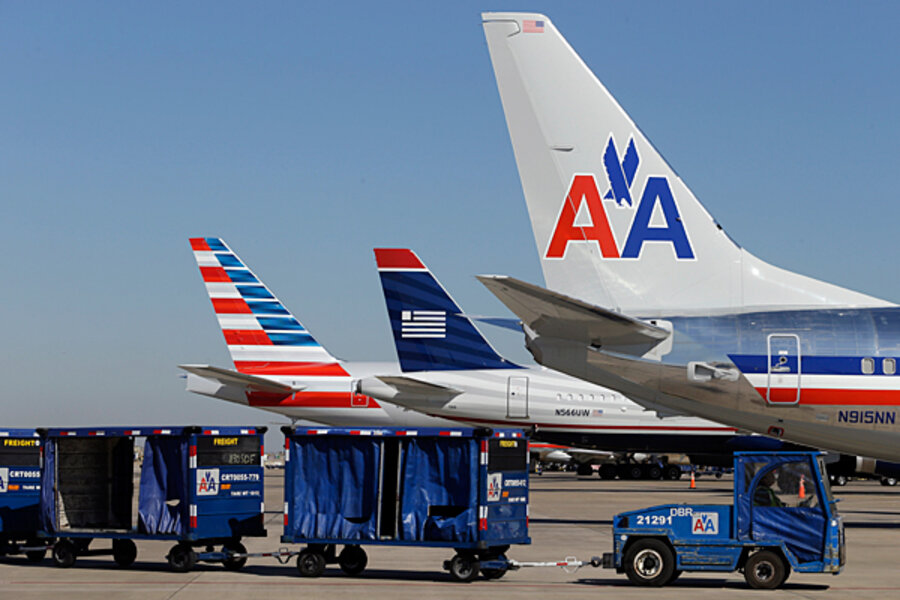American-US Airways $11 billion merger: What's in it for travelers
Loading...
| New York
Capping an era of consolidation in the troubled airline industry, the boards of American Airlines and US Airways agreed to a merger late Wednesday, an $11 billion deal that would create the world's biggest airline with the most passenger seats.
The combined airline will retain the American Airlines name and have more than 6,700 daily flights to 336 destinations in 56 countries.
The merger ends an era of consolidation that has stabilized the airline industry and helped return it to profitability – with mixed results for consumers.
While consumers can expect some turbulence – like modest fare increases – as a result of the merger, analysts say there are some bright spots.
“I’m actually very optimistic,” says George Hobica, founder of discount alert site Airfarewatchdog.com. “We’re going to see an improvement in service … happier airline employees, and newer planes with more amenities.”
The American-US Air merger, which is pending approval by federal regulators, is the final union in a series of mergers that has whittled the US airline industry from 10 major players in 1988 to just three legacy airlines today – Delta, United, and now American. That’s left four airlines, including Southwest, controlling 83 percent of domestic seats.
That consolidation is part of a larger trend many industries have undergone since deregulation, says Clifford Winston, a senior fellow at the Brookings Institution.
“The airline case shouldn’t be taken in isolation of other deregulated industries,” says Mr. Winston. “What we’re seeing in airlines is what we’ve seen in railroads, telecom, and trucking.”
As it has in other markets, consolidation has steadied an airline industry dogged for decades by the effects of deregulation, rising fuel costs, labor problems, and the advent of low-cost competitors. In fact, after a period of bankruptcies and liquidation, the industry is profitable again, with 2013 profits projected at $6.8 billion, according to analyst estimates reported in the Wall Street Journal.
Of course, that consolidation – the final chapter of which is the American-US Air merger – comes at a cost to consumers.
Consumers can expect to see modestly higher fares as a result of the merger, especially in smaller markets where competition is less intense, says Seth Kaplan, an analyst with Airline Weekly magazine. Mr. Kaplan predicts fare increases in the “single digit percentages,” along with fewer choices for consumers.
The merger “ultimately ends up taking a little supply out of the market,” he says. “Having fewer players competing does result in … modestly higher airfares, but it’s still a very competitive industry.”
Consumer complaints also spike immediately following a merger, with two airlines struggling to merge their reservations, luggage, and frequent flyer programs. As such, experts warn consumers to be prepared for more lost luggage, reservation problems, and frequent flyer hiccups, in the near future.
But it’s not all storms and squalls – analysts see a silver lining in the new union.
For one, the merger, and the larger trend of consolidation it represents, brings stability to the industry and to consumers.
“You’ll have fewer crises, fewer bankruptcies, more predictability, more stability,” says Winston.
And increased profitability – thanks to joint operations, economies of scale, and enhanced buying power – means more money to put into services like better seats, more entertainment options, and WiFi, says Kaplan.
“Certainly these companies now for the first time have money to invest in their product,” he says.
The merged airline will also offer consumers more destinations on a single carrier, as well as more hubs to be re-routed through in the case of delays or cancellations.
But the most encouraging news, say analysts, is that fares won’t go up much – if at all.
“Most travel in this country is on big ticket routes,” like New York-LA and New York-Chicago, says Winston. With as many as nine carriers serving the major routes, “those routes will always remain competitive.”
Don’t forget, he adds, “there’s a ready source of willing competitors that can do a lot of damage to high fares.”
Indeed, discount carriers like Spirit and JetBlue still control 37 percent of domestic flights and play an important role in keeping prices in check.
And if history is any indication, domestic fares across the industry will remain moderate. In fact, when adjusted for inflation, domestic fares are actually 15 percent lower today than they were in 2000, according to government data.
Finally, says Mr. Hobica, of Airfarewatchdog.com, if the new American Airlines is able to cut costs by merging operations, purchasing fuel-efficient jets, and eliminating back office expenses, “maybe they won’t even need to raise fares.”







